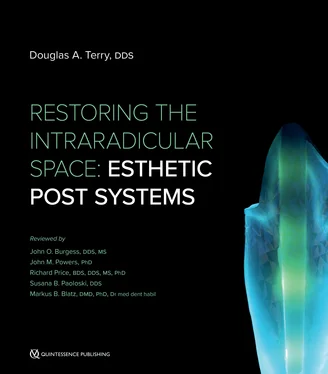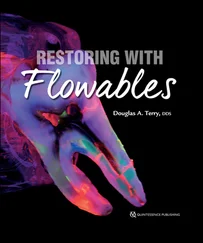1 ...6 7 8 10 11 12 ...18 DIRECT FIBER-REINFORCED POST AND CORE SYSTEM
This composite post and core system offers several advantages: a one-appointment technique, no laboratory fees, resistance to corrosion, solubility, biochemical degradation,202 reduced root fracture, atraumatic retrievability, and increased retention resulting from microretentive bonding surfaces. It also conserves tooth structure and yields biomechanical properties similar to those of the host dental tissue and has no negative effect on esthetics ( Box 1-1).140 ,196 ,206 ,353 ,357 ,426 –429 Disadvantages of the technique include technique sensitivity, the need for a careful adhesive protocol, and the larger inventory of the reinforcement materials.
Box 1-1 Advantages of fiber-reinforced post systems140 ,196 ,206 ,353 ,357 ,426 –429
• One-appointment technique
• Laboratory fees not required
• Resistance to corrosion, solubility, and biochemical degradation
• Have no negative effects on esthetics and are biocompatible
• A negligible incidence of root fracture140 ,206 ,353
• Adhesively bonded fiber posts may reinforce the root206 ,426 ,427
• Increased retention resulting from microretentive bonding surfaces
• Have the potential to conserve tooth structure
• Have greater bond strengths to dentin than zirconia post systems206 ,428
• Possess biomechanical properties similar to those of the host dental tissue (ie, modulus of elasticity, high tensile strength)206 ,357
• Composite resin reinforcement of wall thickness of weakened roots increases the resistance to root fracture206 ,426
• Posts with similar modulus of elasticity to dentin and of smaller diameter are correlated with improved stress distributions206 ,429
• Can be easily modified in shape and length, and materials are of relatively low cost
There are several methods for the fabrication of the direct fiber-reinforced resin post system that include a custom-made glass fiber post system, which uses a polyethylene woven reinforcement fiber, a prefabricated fiber-reinforced composite post, a direct anatomical formed fiber-reinforced post, and a direct/indirect anatomical formed fiber-reinforced post. Prefabricated fiber-reinforced resin posts flex with the tooth structure, are easy to remove if retreatment is required, and have no negative effects on esthetics. However, the adaptation of the prefabricated post to the canal wall is important for retention, and in some cases, the canal must be enlarged to fit the configuration of the selected post, requiring removal of more tooth structure to achieve optimal adaptation. Therefore, these prefabricated posts have optimal adaptation and function in teeth with small circular canals. 89Many roots, however, have irregularly shaped canals, and the prefabricated system is not ideal because of the improper adaptation and the required thickness of the resin cement. This increased cement layer thickness can influence the stress distribution on the restorative assembly and increase the potential risk for the loss of post retention.430 –432 Prospective and retrospective clinical studies have indicated that fiber post dislodgment occurs with greater frequency with thicker cement layers.121 ,388 ,433 The thinner the joint, the greater the strength. Also, there is indication that a thin layer of resin cement provides frictional retention of the post.171 ,434 –436
There are several methods that can be used for the treatment of irregular configurations (oval shape, flared roots), which include the custom-made glass fiber post system that uses a bondable reinforcement fiber (Ribbond-THM; Construct), a direct anatomical formed fiber-reinforced post system that uses a resin composite to modify the shape of the prefabricated post,185 ,437 –439 and a direct/indirect anatomical formed fiber-reinforced post system that entails using a pattern resin to replicate the anatomical configuration of the post channel that can be translated with flowable resin composite in the laboratory or chairside. Other methods suggested in the literature for reducing the thickness of the cement layer include root reinforcement with a composite material,352 ,440 –442 the use of accessory fiber posts,352 ,443 ,444 and the use of an ovoid-shaped post system (Macro-Lock Oval Post, RTD). The custom-made glass fiber post system uses ultrahigh–molecular weight polyethylene woven fiber ribbon (Ribbond-THM; Construct) that is coated with an unfilled light-cured resin bonding adhesive and inserted and adapted with a V-shaped groove condenser into the channel space and light polymerized into an ideal position for the composite core 40 , 42 , 105 ,195 ,196 ,445 ,446 ( Fig 1-14). This method requires minimal preparation because there is no designated orifice size, 42 ,446 and it follows the anatomical form of the endodontically treated tooth. This method can be used for noncircular or ovoid-shaped canals and for retreatment of an enlarged post channel, and it provides improved internal adaptation to the surface irregularities of the root surface. 105 ,195 ,196 It has been indicated that because these woven fibers have a modulus of elasticity similar to dentin, their adhesive assembly with dentin provides a monoblock dentin-post-core system that allows for an optimal distribution of forces along the root. 9 ,361 Also, this method allows additional reinforcing fiber to be placed in the cervical region of the post channel where high tensile stresses occur, thus providing increased fracture resistance.366 ,447 ,448 One clinical trial study report that only 1 out of 42 posts debonded over a 3-year follow-up period. 42 ,449
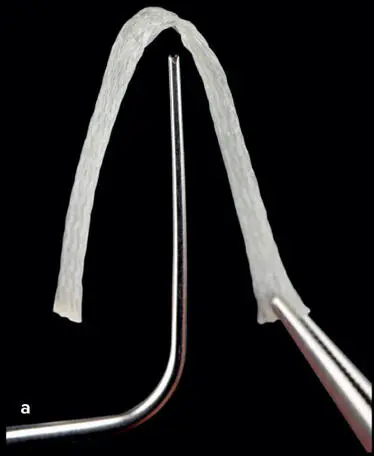
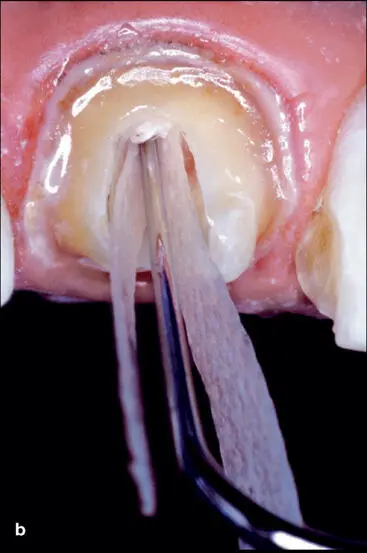
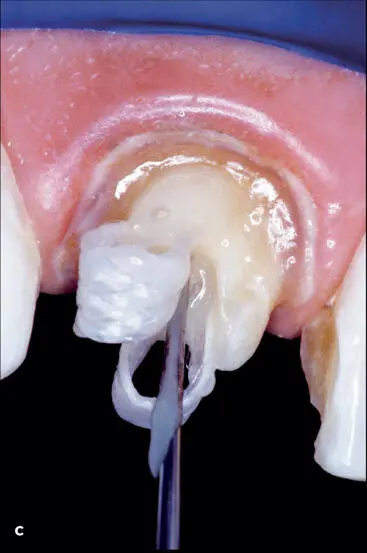



Fig 1-14 (a) A modified Luk’s gutta-percha condenser can be used for placement of the 2-mm gas plasma–coated fiber ribbon (Ribbond-THM). (b and c) After a dual-cured composite resin cement is injected into the post channel, the reinforcement fiber is placed to the base of the post channel, and the ends of the fiber are folded back into the channel and arranged into the desired shape of the core and light cured for 60 seconds. (d) A dual-cured or light-cured composite is injected over the coronal fibers, and the composite material is adapted, sculpted, and smoothed with a #2 sable brush into the desired form and dimension of an ideal preparation. (e) The preparation is completed using a tapered diamond (6850-31-018, Brasseler USA). (f) Finishing and smoothing of the preparation is accomplished using a fine 8-mm diamond bur (DET6, Brasseler USA).
Another method is the direct anatomical formed fiber-reinforced post system that uses a composite to modify the shape of the prefabricated post.185 ,437 ,438 A water-soluble gel is placed on the walls of the prepared channel, and an uncured composite material is applied to the post and inserted into the prepared channel, removed, and then re-inserted to ensure proper adaptation without restriction from undercuts. The fiber post assembly is light cured intraorally for 5 seconds and removed, and the photoactivation is completed outside the tooth.185 Further post-cure procedures can be completed under various combinations of light, heat, pressure, vacuum, and the use of nitrogen to enhance the degree of conversion and to improve the physical and mechanical properties of the composite. This method can be used for noncircular or ovoid-shaped canals to achieve less invasive post-space preparation,366 improved internal adaptation,450 –452 and a uniform cement layer thickness. Furthermore, this anatomically formed system can be used for the retreatment of large post spaces to reduce the cement layer thickness. This technique is similar to the method used for the fabrication of the conventional-cast post and core.366 The application of the anatomical formed post system decreases the volume of adhesive material in the post space, thus minimizing the potential for gap formation at the dentin-cement interface,440 ,453 while also reducing the undesirable effects of polymerization shrinkage while increasing bond strengths.388 ,454 In addition, post curing of the relined post can improve some mechanical properties of the fiber-reinforced composite post.455
Читать дальше
